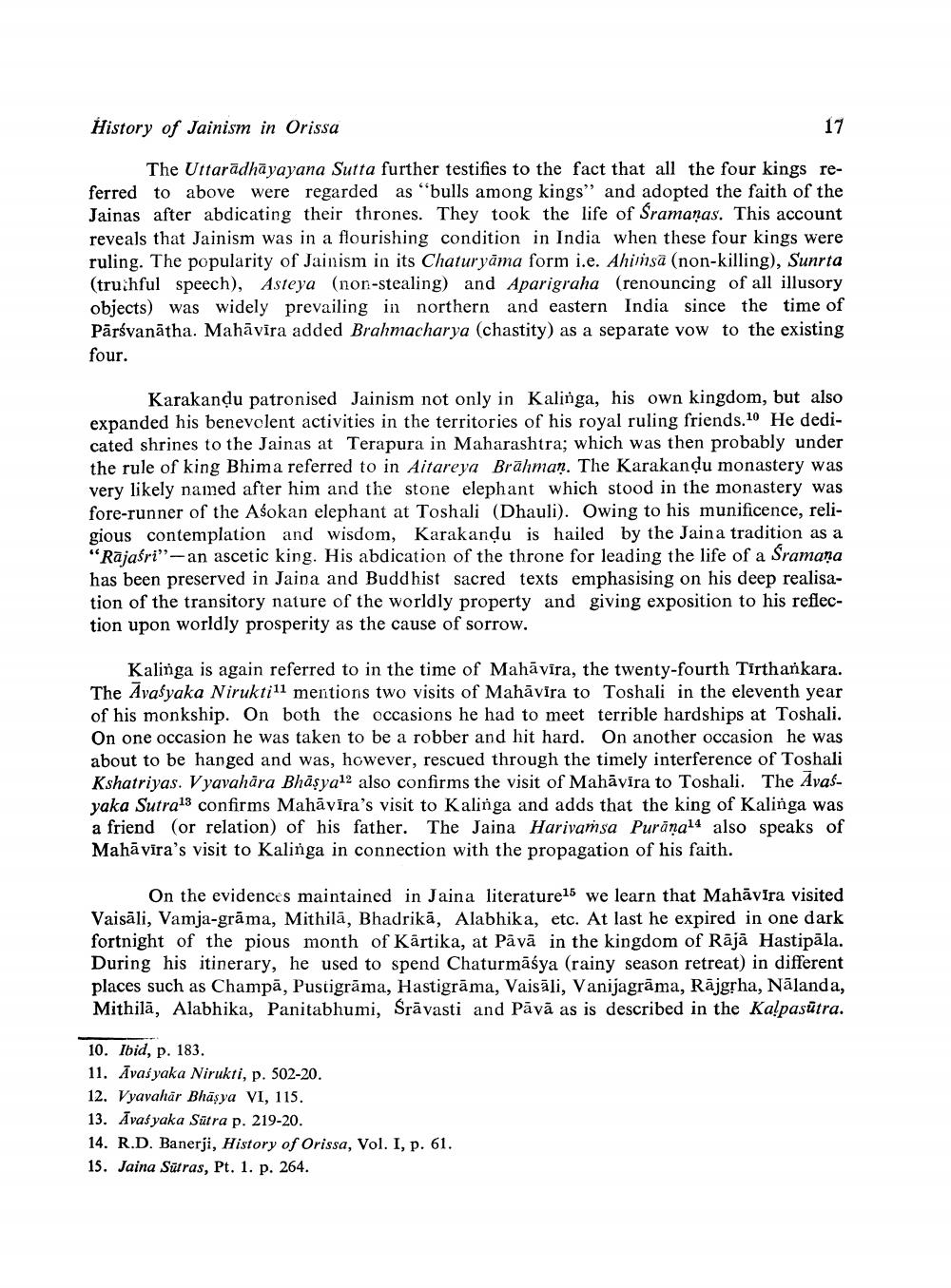________________
History of Jainism
in Orissa
17
The Uttarādhāyayana Sutta further testifies to the fact that all the four kings referred to above were regarded as "bulls among kings" and adopted the faith of the Jainas after abdicating their thrones. They took the life of Sramaņas. This account reveals that Jainism was in a flourishing condition in India when these four kings were ruling. The popularity of Jainism in its Chaturyāma form i.e. Ahimsa (non-killing), Sunrta (truchful speech), Asteya (non-stealing) and Aparigraha (renouncing of all illusory objects) was widely prevailing in northern and eastern India since the time of Pārsvanātha. Mahāvira added Brahmacharya (chastity) as a separate vow to the existing four.
Karakandu patronised Jainism not only in Kalinga, his own kingdom, but also expanded his benevolent activities in the territories of his royal ruling friends.10 He dedicated shrines to the Jainas at Terapura in Maharashtra; which was then probably under the rule of king Bhima referred to in Aitareya Brahman. The Karakandu monastery was very likely named after him and the stone elephant which stood in the monastery was fore-runner of the Asokan elephant at Toshali (Dhauli). Owing to his munificence, religious contemplation and wisdom, Karakandu is hailed by the Jaina tradition as a "Rājasri'-an ascetic king. His abdication of the throne for leading the life of a Sramaņa has been preserved in Jaina and Buddhist sacred texts emphasising on his deep realisation of the transitory nature of the worldly property and giving exposition to his reflection upon worldly prosperity as the cause of sorrow.
Kalinga is again referred to in the time of Mahāvīra, the twenty-fourth Tirthankara. The Avasyaka Niruktill mentions two visits of Mahāvīra to Toshali in the eleventh year of his monkship. On both the occasions he had to meet terrible hardships at Toshali. On one occasion he was taken to be a robber and hit hard. On another occasion he was about to be hanged and was, however, rescued through the timely interference of Toshali Kshatriyas. Vyavahāra Bhāşyal2 also confirms the visit of Mahāvīra to Toshali. The Avasyaka Sutra13 confirms Mahāvīra's visit to Kalinga and adds that the king of Kalinga was a friend (or relation) of his father. The Jaina Harivamsa Puranal4 also speaks of Mahā vīra's visit to Kalinga in connection with the propagation of his faith.
On the evidencés maintained in Jaina literature15 we learn that Mahāvīra visited Vaisāli, Vamja-grāma, Mithila, Bhadrikā, Alabhika, etc. At last he expired in one dark fortnight of the pious month of Kārtika, at Pavā in the kingdom of Rājā Hastipāla. During his itinerary, he used to spend Chaturmāsya (rainy season retreat) in different places such as Champā, Pustigrāma, Hastigrāma, Vaisāli, Vanijagrāma, Rājgrha, Nalanda, Mithila, Alabhika, Panitabhumi, Srāvasti and Pāvā as is described in the Kalpasūtra.
10. Ibid, p. 183. 11. Āvas yaka Nirukti, p. 502-20. 12. Vyavahār Bhāşya VI, 115. 13. Āvas yaka Sūtra p. 219-20. 14. R.D. Banerji, History of Orissa, Vol. I, p. 61. 15. Jaina Sūtras, Pt. 1. p. 264.




